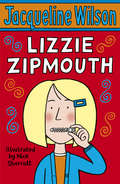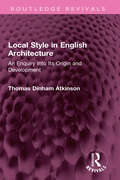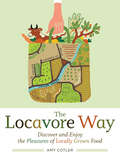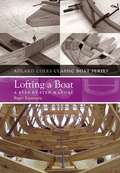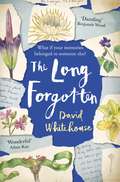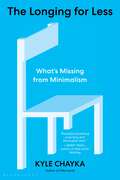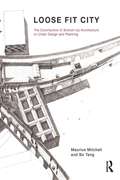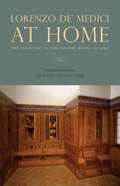- Table View
- List View
Lizzie Zipmouth
by Jacqueline Wilson Nick SharrattLizzie refuses to speak. She doesn't want to talk to Rory or Jake, her new stepbrothers. Or to Sam, their dad. Or even to her mum. She's completely fed up with having to join a new family, and nothing can convince her to speak to them. Not football, not pizza, not a new bedroom. That is, until she meets Great-Gran - a member of the new family who is even more stubborn than she is . . .
Local Style in English Architecture: An Enquiry Into Its Origin and Development (Routledge Revivals)
by Thomas AtkinsonOriginally published in 1947, this book examines the regional styles of architecture which developed inside England itself, particularly during the later medieval period. It discusses the causes and locations of these regional variations. In explaining the cause for the geographical variations in stye, the author investigates the various factors responsible for bringing them about, such as geology, race, religion, foreign influence, transport and fashion. As churches have survived the passage of time better than many secular buildings, the emphasis is on church architecture (although not exclusively). The book contains over 120 photographs and the book is an original and important inquiry into the origin and development of local styles in English architecture.
Local Style in English Architecture: An Enquiry Into Its Origin and Development (Routledge Revivals)
by Thomas AtkinsonOriginally published in 1947, this book examines the regional styles of architecture which developed inside England itself, particularly during the later medieval period. It discusses the causes and locations of these regional variations. In explaining the cause for the geographical variations in stye, the author investigates the various factors responsible for bringing them about, such as geology, race, religion, foreign influence, transport and fashion. As churches have survived the passage of time better than many secular buildings, the emphasis is on church architecture (although not exclusively). The book contains over 120 photographs and the book is an original and important inquiry into the origin and development of local styles in English architecture.
The Locavore Way: Discover and Enjoy the Pleasures of Locally Grown Food
by Amy CotlerEating food grown close to home is not only tasty, but comes with great benefits for the health of your family, your local community, and the environment. Learn how and where to find local foods, how to eat locally on a tight budget, what questions to ask at the farmers&’ market, and how to grow your own food in small spaces. With shopping tips and simple guides to preparing what&’s in season, The Locavore Way makes eating locally as simple as it is delicious.
Lofting a Boat: A Step-by-Step Manual (The Adlard Coles Classic Boat series)
by Roger KopanyciaThe second book in our Classic Boat series aimed at traditional boat lovers, builders and restorers.Lofting is an essential stage in the transition between designing andbuilding a boat in order to turn the design plans intoboat lines plans to measure off and build thefull-size boat. Its a tricky art, but this book shows exactly how it is done inclear, step-by-step diagrammatic stages. Aimed specifically at theamateur DIY builder, it will enable anyone to build a boat of any size,whether power or sail. The author has been teaching lofting to boatbuilding students for over10 years, and has found that the key to understanding is visualisation- hence the plethora of step-by-step diagrams in this book to assist the reader to grasp the concepts. Lofting will be welcomed by budding boatbuilders everywhere.
Lofting a Boat: A Step-by-Step Manual (The\adlard Coles Classic Boat Ser.)
by Roger KopanyciaThe second book in our Classic Boat series aimed at traditional boat lovers, builders and restorers.Lofting is an essential stage in the transition between designing andbuilding a boat in order to turn the design plans intoboat lines plans to measure off and build thefull-size boat. Its a tricky art, but this book shows exactly how it is done inclear, step-by-step diagrammatic stages. Aimed specifically at theamateur DIY builder, it will enable anyone to build a boat of any size,whether power or sail. The author has been teaching lofting to boatbuilding students for over10 years, and has found that the key to understanding is visualisation- hence the plethora of step-by-step diagrams in this book to assist the reader to grasp the concepts. Lofting will be welcomed by budding boatbuilders everywhere.
Log Cabin (Large Print)
This image shows a gable wall view of a cabin constructed from logs. There is a locator dot shown which will be at the top left of the page when the image is the right way up. The pointed roof fills the top half of the page. The rounded ends of the supporting logs are shown down from the two sloping surfaces of the roof. On the right side of the image there is a crooked chimney sticking out from the roof. Down from the roof is the wall of the cabin. Here the rounded ends of the logs making up the side walls are shown at the left and right edges of the image, and these interleave with the slightly irregular length logs making up the wall shown. In the centre of this wall is a wooden door with a large door knob and ledges above and below it. At each side of the door there is a window with wooden ledges to top and bottom.
Log Cabin (UEB Contracted)
This image shows a gable wall view of a cabin constructed from logs. There is a locator dot shown which will be at the top left of the page when the image is the right way up. The pointed roof fills the top half of the page. The rounded ends of the supporting logs are shown down from the two sloping surfaces of the roof. On the right side of the image there is a crooked chimney sticking out from the roof. Down from the roof is the wall of the cabin. Here the rounded ends of the logs making up the side walls are shown at the left and right edges of the image, and these interleave with the slightly irregular length logs making up the wall shown. In the centre of this wall is a wooden door with a large door knob and ledges above and below it. At each side of the door there is a window with wooden ledges to top and bottom.
Log Cabin (UEB uncontracted)
This image shows a gable wall view of a cabin constructed from logs. There is a locator dot shown which will be at the top left of the page when the image is the right way up. The pointed roof fills the top half of the page. The rounded ends of the supporting logs are shown down from the two sloping surfaces of the roof. On the right side of the image there is a crooked chimney sticking out from the roof. Down from the roof is the wall of the cabin. Here the rounded ends of the logs making up the side walls are shown at the left and right edges of the image, and these interleave with the slightly irregular length logs making up the wall shown. In the centre of this wall is a wooden door with a large door knob and ledges above and below it. At each side of the door there is a window with wooden ledges to top and bottom.
London in the Wild: Exploring Nature in the City
by London Wildlife Trust'London in the Wild is a timely opportunity to get out and explore all the wild spaces and natural places that exist alongside us. Both on your doorstep and on the other side of the river.' - Chris Packham A place of cars, concrete, lights, noise and pollution, London is a harsh, unyielding landscape created to meet the needs of people, not wildlife, but if you take the time to stop and look, you'll discover it is teeming with more than 15,000 species of flora, fungi and fauna, including marsh frogs, hedgehogs, short-eared owls and dragonflies. With London in the Wild as your guide, you can explore the city from your garden, local parks and community space, but also from its wetlands, woodlands and heaths. Along the way you'll discover the best places to see bluebells in springtime, the day-to-day life of a London Tube mouse and the activities of seals who make their home in the Thames.
London’s Royal Parks (Shire Library #793)
by Paul RabbittsLondon's royal parks are amongst its most beautiful and beloved spaces: just as much as the Houses of Parliament, Buckingham Palace and Victoria Station, the mere mention of Hyde or Regent's Park is enough to evoke the capital in all its glory for residents and tourists alike. They have a grand history – some having been royally-owned as far back as the Norman conquest, and others having been acquired by Henry VIII during the Reformation – and since being opened to the public during the eighteenth century have hosted some of London's great events, including the Great Exhibition and innumerable jubilees and celebrations. This book tells the story of all nine of the parks from the point when they were acquired by the monarchy until the present day, including the major historic moments and events with which they are associated.
London’s Royal Parks (Shire Library)
by Paul RabbittsLondon's royal parks are amongst its most beautiful and beloved spaces: just as much as the Houses of Parliament, Buckingham Palace and Victoria Station, the mere mention of Hyde or Regent's Park is enough to evoke the capital in all its glory for residents and tourists alike. They have a grand history – some having been royally-owned as far back as the Norman conquest, and others having been acquired by Henry VIII during the Reformation – and since being opened to the public during the eighteenth century have hosted some of London's great events, including the Great Exhibition and innumerable jubilees and celebrations. This book tells the story of all nine of the parks from the point when they were acquired by the monarchy until the present day, including the major historic moments and events with which they are associated.
London's Strangest Tales: Extraordinary But True Stories (Strangest Ser.)
by Iain SpraggLondon's Royal Palaces are still some of the most visited places in England. A great deal of their official histories are well known. But London's Strangest Tales: Historic Royal Palaces reveals the bizarre, funny and surreal events and episodes that have occurred over the centuries on the grounds of these beautiful buildings. It gives an alternative history: from the wandering inebriated zebras at the Tower of London, the cricket ball that probably killed a king, and the mystery of Kew's disappearing mosque. This is a wonderful collection for anyone with an interest in the history and heritage of our palaces and in London life generally.
The Long Forgotten
by David WhitehouseMemories make us who we are – but what if yours belonged to someone else?David Whitehouse's The Long Forgotten is the story of a missing plane, a rare-flower hunter, and a lonely young man who has begun to remember a past that isn’t his. It’s the story of a long-buried mystery, a quest that ended in tragedy, and a love that can never be forgotten.'This is a wonderful book, its different strands weaving around each other and coming together in the most fantastic conclusion. I am so jealous of David Whitehouse’s writing.' Adam Kay'Powerful, eccentric . . . Whitehouse's writing is energetic and pacey, spiked with startling moments of tenderness and superbly controlled' The Times
Long-Lasting Hanging Plants: Storey's Country Wisdom Bulletin A-147 (Storey Country Wisdom Bulletin)
by Rhonda Massingham HartSince 1973, Storey's Country Wisdom Bulletins have offered practical, hands-on instructions designed to help readers master dozens of country living skills quickly and easily. There are now more than 170 titles in this series, and their remarkable popularity reflects the common desire of country and city dwellers alike to cultivate personal independence in everyday life.
The Longing for Less: Living with Minimalism
by Kyle Chayka"More than just a story of an abiding cultural preoccupation, The Longing For Less peels back the commodified husk of minimalism to reveal something surprising and thoroughly alive." -Jenny Odell, author of How to Do Nothing "Thoughtful and absorbing . . . A superb outing from a gifted young critic that will spark joy in many readers." -Kirkus Reviews, starred review “Less is more”: Everywhere we hear the mantra. Marie Kondo and other decluttering gurus promise that shedding our stuff will solve our problems. We commit to cleanse diets and strive for inbox zero. Amid the frantic pace and distraction of everyday life, we covet silence-and airy, Instagrammable spaces in which to enjoy it. The popular term for this brand of upscale austerity, “minimalism,” has mostly come to stand for things to buy and consume. But minimalism has richer, deeper, and altogether more valuable gifts to offer. Kyle Chayka is one of our sharpest cultural observers. After spending years covering minimalist trends for leading publications, he now delves beneath this lifestyle's glossy surface, seeking better ways to claim the time and space we crave. He shows that our longing for less goes back further than we realize. His search leads him to the philosophical and spiritual origins of minimalism, and to the stories of artists such as Agnes Martin and Donald Judd; composers such as John Cage and Julius Eastman; architects and designers; visionaries and misfits. As Chayka looks anew at their extraordinary lives and explores the places where they worked-from Manhattan lofts to the Texas high desert and the back alleys of Kyoto-he reminds us that what we most require is presence, not absence. The result is an elegant new synthesis of our minimalist desires and our profound emotional needs.
Loose Fit City: The Contribution of Bottom-Up Architecture to Urban Design and Planning
by Maurice Mitchell Bo TangDrawn from a lifetime’s experience of shared city-making from the bottom up, within rapidly expanding urban metabolisms in Delhi, Mumbai, Agra, Kathmandu, West Africa and London, Loose Fit City is about the ways in which city residents can learn through making to engage with the dynamic process of creating their own city. It looks at the nature and processes involved in loosely fitting together elements made by different people at different scales and times, with different intentions, into a civic entity which is greater than the sum of its parts. It shows how bottom-up learning through making can create a more vibrant and democratic city than the more flattened, top-down, centrally planned, factory made version. Loose Fit City provides a new take on the subject of architecture, defined as the study and practice of fitting together physical and cultural topography. It provides a comprehensive view of how the fourth dimension of time fits loosely together with the three spatial dimensions at different scales within the human horizon, so as to layer meaning and depth within the places and metabolism of the city fabric.
Loose Fit City: The Contribution of Bottom-Up Architecture to Urban Design and Planning
by Maurice Mitchell Bo TangDrawn from a lifetime’s experience of shared city-making from the bottom up, within rapidly expanding urban metabolisms in Delhi, Mumbai, Agra, Kathmandu, West Africa and London, Loose Fit City is about the ways in which city residents can learn through making to engage with the dynamic process of creating their own city. It looks at the nature and processes involved in loosely fitting together elements made by different people at different scales and times, with different intentions, into a civic entity which is greater than the sum of its parts. It shows how bottom-up learning through making can create a more vibrant and democratic city than the more flattened, top-down, centrally planned, factory made version. Loose Fit City provides a new take on the subject of architecture, defined as the study and practice of fitting together physical and cultural topography. It provides a comprehensive view of how the fourth dimension of time fits loosely together with the three spatial dimensions at different scales within the human horizon, so as to layer meaning and depth within the places and metabolism of the city fabric.
Loose Space: Possibility and Diversity in Urban Life
by Karen A. Franck Quentin StevensIn cities around the world people use a variety of public spaces to relax, to protest, to buy and sell, to experiment and to celebrate. Loose Space explores the many ways that urban residents, with creativity and determination, appropriate public space to meet their own needs and desires. Familiar or unexpected, spontaneous or planned, momentary or long-lasting, the activities that make urban space loose continue to give cities life and vitality. The book examines physical spaces and how people use them. Contributors discuss a wide range of recreational, commercial and political activities; some are conventional, others are more experimental. Some of the activities occur alongside the intended uses of planned public spaces, such as sidewalks and plazas; other activities replace former uses, as in abandoned warehouses and industrial sites. The thirteen case studies, international in scope, demonstrate the continuing richness of urban public life that is created and sustained by urbanites themselves Presents a fresh way of looking at urban public space, focusing on its positive uses and aspects. Comprises 13 detailed, well-illustrated case studies based on sustained observation and research by social scientists, architects and urban designers. Looks at a range of activities, both everyday occurrences and more unusual uses, in a variety of public spaces -- planned, leftover and abandoned. Explores the spatial and the behavioral; considers the wider historical and social context. Addresses issues of urban research, architecture, urban design and planning. Takes a broad international perspective with cases from New York, London, Berlin, Amsterdam, Rome, Guadalajara, Athens, Tel Aviv, Melbourne, Bangkok, Kandy, Buffalo, and the North of England.
Loose Space: Possibility and Diversity in Urban Life
by Karen Franck Quentin StevensIn cities around the world people use a variety of public spaces to relax, to protest, to buy and sell, to experiment and to celebrate. Loose Space explores the many ways that urban residents, with creativity and determination, appropriate public space to meet their own needs and desires. Familiar or unexpected, spontaneous or planned, momentary or long-lasting, the activities that make urban space loose continue to give cities life and vitality. The book examines physical spaces and how people use them. Contributors discuss a wide range of recreational, commercial and political activities; some are conventional, others are more experimental. Some of the activities occur alongside the intended uses of planned public spaces, such as sidewalks and plazas; other activities replace former uses, as in abandoned warehouses and industrial sites. The thirteen case studies, international in scope, demonstrate the continuing richness of urban public life that is created and sustained by urbanites themselves Presents a fresh way of looking at urban public space, focusing on its positive uses and aspects. Comprises 13 detailed, well-illustrated case studies based on sustained observation and research by social scientists, architects and urban designers. Looks at a range of activities, both everyday occurrences and more unusual uses, in a variety of public spaces -- planned, leftover and abandoned. Explores the spatial and the behavioral; considers the wider historical and social context. Addresses issues of urban research, architecture, urban design and planning. Takes a broad international perspective with cases from New York, London, Berlin, Amsterdam, Rome, Guadalajara, Athens, Tel Aviv, Melbourne, Bangkok, Kandy, Buffalo, and the North of England.
Lorenzo De' Medici At Home: The Inventory Of The Palazzo Medici In 1492 (PDF)
by Richard StaplefordLorenzo il Magnifico de' Medici was the head of the ruling political party at the apogee of the golden age of Quattrocento Florence. Born in 1449, his life was shaped by privilege and responsibility, and his deeds as a statesman were legendary even while he lived. At his death he was master of the largest and most famous private palace in Florence, a building crammed full of the household goods of four generations of Medici as well as the most extraordinary collections of art, antiquities, books, jewelry, coins, cameos, and rare vases in private hands. His heirs undertook an inventory of the estate, a usual procedure following the demise of an important head of family. An anonymous clerk, pen and paper in hand, walked through the palace from room to room, counting and recording the barrels of wine and the water urns; opening cabinets and chests; unfolding and examining clothes, fabrics, and tapestries; describing the paintings he saw on the walls; and unlocking jewel boxes and weighing and evaluating coins, medals, necklaces, brooches, rings, and cameos. The original document he produced has been lost, but a copy was made by another clerk in 1512. Richard Stapleford's critical translation of this document offers the reader a window onto the world of the Medici family, their palace, and the material culture that surrounded them.
The Lost Gardens Of Heligan: A Portrait Of The Lost Gardens
by Tim SmitThe glorious No.1 bestsellerUntil the First World War, the estate gardens at Heligan were one of the glories of Cornwall. Thereafter, through growing neglect, they slipped gradually to sleep. This is the amazing story of their rediscovery and restoration, or the Victorian vision and ingenuity which first created that subtropical paradise, and of the modern obsession and improvisation which recreated it.
Lost in the Transit Desert: Race, Transit Access, and Suburban Form
by Diane Jones AllenIncreased redevelopment, the dismantling of public housing, and increasing housing costs are forcing a shift in migration of lower income and transit dependent populations to the suburbs. These suburbs are often missing basic transportation, and strategies to address this are lacking. This absence of public transit creates barriers to viable employment and accessibility to cultural networks, and plays a role in increasing social inequality. This book investigates how housing and transport policy have played their role in creating these "Transit Deserts," and what impact race has upon those likely to be affected. Diane Jones Allen uses research from New Orleans, Baltimore, and Chicago to explore the forces at work in these situations, as well as proposing potential solutions. Mapping, interviews, photographs, and narratives all come together to highlight the inequities and challenges in Transit Deserts, where a lack of access can make all journeys, such as to jobs, stores, or relatives, much more difficult. Alternatives to public transit abound, from traditional methods such as biking and carpooling to more culturally specific tactics, and are examined comprehensively. This is valuable reading for students and researchers interested in transport planning, urban planning, city infrastructure, and transport geography.
Lost in the Transit Desert: Race, Transit Access, and Suburban Form
by Diane Jones AllenIncreased redevelopment, the dismantling of public housing, and increasing housing costs are forcing a shift in migration of lower income and transit dependent populations to the suburbs. These suburbs are often missing basic transportation, and strategies to address this are lacking. This absence of public transit creates barriers to viable employment and accessibility to cultural networks, and plays a role in increasing social inequality. This book investigates how housing and transport policy have played their role in creating these "Transit Deserts," and what impact race has upon those likely to be affected. Diane Jones Allen uses research from New Orleans, Baltimore, and Chicago to explore the forces at work in these situations, as well as proposing potential solutions. Mapping, interviews, photographs, and narratives all come together to highlight the inequities and challenges in Transit Deserts, where a lack of access can make all journeys, such as to jobs, stores, or relatives, much more difficult. Alternatives to public transit abound, from traditional methods such as biking and carpooling to more culturally specific tactics, and are examined comprehensively. This is valuable reading for students and researchers interested in transport planning, urban planning, city infrastructure, and transport geography.
Lost Informal Housing in Istanbul: Globalization at the Expense of Urban Culture
by F. Yurdanur Dulgeroglu-YukselThe dynamics of globalization brought a radical change in megacities and tensions between the stakeholders and dwellers against top-down urban renewal policies. This unique book provides a worldview of multi-stakeholders in the urban housing market. With a longitudinal research approach, it paves the way for interdisciplinary researchers to critically assess the urban renewal projects and update such studies. The urban renewal processes are implemented without participation, and the book highlights field-based information for policymakers. The reader will find, with the information provided from the field, why participation is necessary for a sustainable urban development, why there are different types of urbanizations, and how it works under different conditions. Better understanding of the challenges of urban renewal processes in the world cities is intended with the focus on the changing informal settlements. Istanbul is a megacity, housing more than half of its dwellers in informal settlements. After many decades of self-upgrading and silently communicating with the local authorities, the informal sector had become adapted and maintained its living spaces. Unexpectedly, the end of the first decade of the 21st century marked a radical urban land valuation and international investments. Top-down interventions started with naming Istanbul the 2010 European Capital of Culture. Then came the Law of Urban Transformation, which meant the fast decline of squatter housing and the speedy loss of its cultural value of the mahalle spirit, place identity. The book will raise curiosity on why the time has come to change the perspectives about the informal urban sector.
